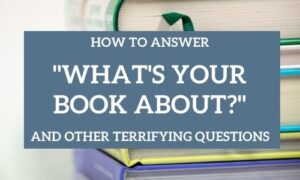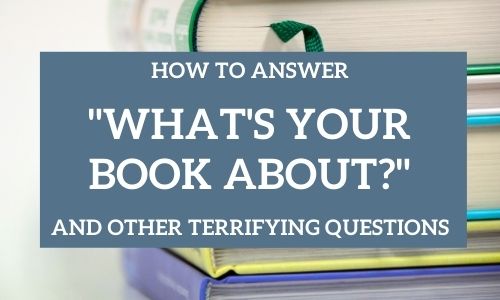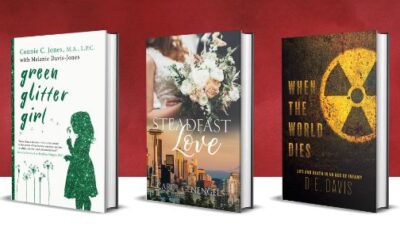 By Jori Hanna
By Jori Hanna
There is one question most authors dread more than any other question in the world. Your friends ask it, your family asks it, your followers ask it. And someday, your readers will ask it, too.
“What’s your book about?”
No matter what stage of the writing process you’re in—whether you’re just beginning the first draft or you’re sitting at a table in a bookstore for an author signing, this question (or some variation on it) will crop up.
So how do you answer it? How do you take all your hours of passion and research and boil it down to an answer that won’t scare off the asker?
Nailing down how to do this will help you in every stage of marketing your book—whether you’re trying to land an agent or publisher or trying to gather interest from readers.
Some books are easier to talk about than others. Nonfiction tends to have a more obvious answer to this question. After all, you likely wrote your nonfiction book to educate, entertain, or spread awareness through your personal experience.
Our author Dave Iverson answered this question well when he said that his book, Winter Stars, is about the ten-year-long caregiving odessy he experienced and the lessons he learned about love and life when he moved in with his 98-year-old mother to care for her.
Another of our authors, Mel Friedman, answered this question well when he said that his memoir, Where Spirit Touches Matter, is an inspection of his personal journey toward wholeness and healing.
But fiction tends to be a little trickier to talk about. When the book is fast-paced, and you’re close enough to every single character to know their personal journeys and stories and areas of growth, it can be incredibly difficult to nail down the heart of the book you wrote. This is often difficult for authors of fiction because their books are about many things. An entire fictional life is contained within those pages. How do you nail down what a life is about?
You take a few steps back and focus on the main threads. Do your best to set down any side characters and any B plots. Who are the main characters, what happens to them, why does it matter, and how do they come through it?
Most of the time when someone asks an author about their book, they’re trying to decide if they want to read the book. If your book is fiction, focus on the key points of the plot. If they ask about what inspired you to write, or where the idea came from, that’s when you can and should dig into more of those specific details. The story behind the story, if you will. But only if they ask for more information about the writing of the book. That’s when you know you have them hooked.
If your book is in production at a publishing house, the marketing team likely has marketing copy that will be used online and on the back of the book. That marketing copy is designed to answer this question. Read it over and over again until you know what the focus of the marketing copy is. When people ask you to tell them about your book, tell them the heart of the back cover copy.
[Click here to read about the different types of marketing copy and other publishing terms.]
If you don’t have that at your disposal yet because you’re still working toward publication, or if you have to write your own copy because you’re self-publishing, focus on the four key questions mentioned above. We’ll look at one of our more recent mysteries as an example—Murder on Hollywood Beach by Carol Finizza.
Who are your main characters?
Even in an ensemble cast, you will have a main character who stands out the most. This is usually the character that has the most “screen time” or the character who makes things happen. This is the character you would want to see on the cover. Your main character may not be who you thought it was when you started writing. Really pay attention to which characters drive the action and who you are most passionate about. Ask a friend or two to read it and ask them who they rooted for most. Whichever character solves the most plot problems is probably your main character, even if you have four or five that share screen time evenly.
Murder on Hollywood Beach sports a cast as vivid as life itself, but the main character is Amanda Beckwith. Almost everyone else can be ignored for the purpose of answering this question.
What happens to this main character?
This is what we like to call the “inciting incident.” What happened that caused this main character to begin their journey? What made them choose to get involved?
For Amanda in Murder on Hollywood Beach, her husband’s lover Bree is discovered dead on the beach behind Amanda’s house, giving the detectives more than enough evidence to single her out as a person of interest.
Why does this matter?
If the main character hadn’t gotten involved, what would have happened? Why does the main character (and therefore the reader) care what happens in this book? This question will determine the stakes of your story.
If Amanda Beckwith hadn’t gotten involved to solve Bree’s murder, she would have likely gone to jail for a crime she didn’t commit, because very few people will listen to her side of the story.
How does the main character come through?
Do their friends help them? Do they go off on their own to prove their innocence? Do they play by the rules and hope for the best? Do they finally tell one of the side characters how they’ve been feeling, or confess a secret they’ve been keeping and put their reputation (or their life, depending on the book) on the line?
In Murder on Hollywood Beach, Amanda must resort to her own devices to clear her name.
Once you’ve answered those four questions as concisely as you can, put them all together into one or two sentences. Now you have a solid pitch to use on Twitter, in person, at your next family dinner, or when you talk with a literary agent or an editor.
It’s time to put your new skills into practice. Our submissions are open, and we would love to hear about your book.

